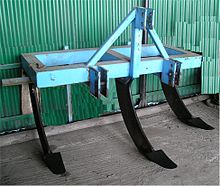Plow sole
The plow sole , also plow sole compaction , is the transition from a worked topsoil to a soil area that has been compacted by plowing, to the depth into which the plow reaches. If the soil is worked when the weather is too wet, a densely lubricated, relatively poorly permeable layer with a damming effect can arise - according to Ellenberg - in both pseudogley-like soils and parabrown soils .
The deep growth of the cultivated plants is impaired, since it is more difficult for the plow to root through. At the same time, the water accumulates in the topsoil area after heavy rainfall.
Attempts are made to repair this type of soil compaction by breaking up the soil with a subsoiler in dry conditions and then stabilizing it with the sowing of deep-rooted catch crops.
Web links
- Soil- conserving agriculture with a detailed view of the plowing process, bodenwelten.de, accessed 2014
Individual evidence
- ↑ Heinz Ellenberg : Vegetation of Central Europe with the Alps in an ecological, dynamic and historical perspective. 5th, heavily changed and improved edition. Ulmer, Stuttgart 1996, ISBN 3-8001-2696-6 , p. 887.

